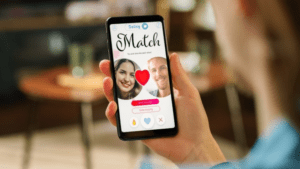Tinder Tests New AI Feature to Scan Camera Roll and Find Better Matches by Getting to Know Users
Tinder is testing a cutting-edge AI feature that analyzes your camera roll to deliver better matches. This interactive matching feature, called Chemistry, is being piloted in New Zealand and Australia, and it’s unlike anything we’ve seen before in the world of online dating.
In a move that signals a shift toward smarter, more intuitive tech, Tinder wants to get to know users beyond just a few curated profile photos. Instead, it will allow its algorithm to scan selected images from a user’s camera roll, learning about their lifestyle, personality, and preferences.
This new AI-powered feature is an opt-in tool — you choose what to share — but it could represent a massive leap forward in creating compatible matches that align with your true self, not just what you write in your bio. According to a Tinder spokesperson, this is a “major pillar of Tinder’s upcoming 2026 product experience.”
How Does the AI Camera Roll Feature Actually Work?
Built using advanced AI and machine learning, the new Tinder feature takes selected images from your camera roll and analyzes them using computer vision.
Here’s what it does:
- Scans the background, lighting, and emotional tone of photos
- Detects interests and personality markers (e.g., hiking, travel, pets, food)
- Evaluates frequency of social vs. solo photos
- Looks at patterns to suggest highly relevant profiles
All of this contributes to helping Tinder find better matches — not just based on attractiveness or location, but on who you really are.
Why Would Tinder Want to Access Camera Roll Photos?
This new tool is designed to better understand users’ lifestyles and values in a way that goes beyond what current dating app algorithms allow. As Tinder’s parent company, Match Group, explained during a recent earnings call, this is about using AI to scan and make sense of rich, visual data to improve the overall product experience.
It’s a continuation of Match Group’s broader strategy: using AI in other areas of its dating platforms to match people more effectively — not just based on swipes, but on deeper indicators of compatibility.
Benefits of Using AI in a Dating App: Is It Worth It?
The integration of AI-powered tools into dating apps has the potential to completely change the way we meet people online. Here are the most exciting benefits of Tinder’s AI rollout:
- Compatible matches and more engaging conversations: Better alignment with lifestyle and interests
- Reduce dating app fatigue: No more endless swiping without results
- More accurate profile suggestions thanks to interactive matching
- Less pressure on users to perfectly curate their profile
- A more personalized product experience that evolves over time
How the AI Feature Could Change Dating App Culture
One of the main challenges in online dating is “swipe fatigue” — users getting tired of repetitive, low-quality interactions. Tinder is testing a new way to fight this by letting the AI feature do more of the work. Instead of judging someone based solely on one or two selfies, the app will present matches based on emotional tone, context, and activity from your real-life photos.
This shift could make free users and premium subscribers feel like they’re getting more meaningful value from the app.
Privacy Concerns: How Safe Is Tinder’s AI Access to Photos?
Let’s address the obvious: Tinder isn’t exactly shy about exploring new tech, but this one hits close to home — literally. Requesting access to users’ private photos is a serious step.
Is Tinder Storing or Sharing Your Photos?
- The feature is opt-in, so you choose which photos to share
- It does not access the camera roll photos without explicit permission
- Photos used are processed for analysis, not saved or distributed
- There’s no indication of long-term storage or third-party sharing
- There is currently no facial verification involved, though that may come later
Tinder’s parent company, Match Group, has stated this is a closed test being piloted in New Zealand, and any expansion would be done with full transparency.
If you’re someone who worries about data access, know that this new feature is still in early stages, and full details of how long photos are kept — or how they’re used — have yet to be released.
Tinder vs Other Dating Apps: Who’s Winning the AI Race?
Tinder tests bold new tech, but it’s not alone. Here’s how it stacks up:
- Hinge is already implementing features that ask users interactive questions to better personalize suggestions
- Meta (parent of Facebook) uses AI to recommend potential matches based on shared interests and profile activity
- Bumble has begun to use AI to suggest edits to user bios and photos
- Even newer apps are incorporating AI access to bios and chat analysis for real-time compatibility scoring
That said, Tinder’s AI feature is arguably the most advanced — it’s not just enhancing what users provide; it’s going deeper by analyzing who they are in daily life.
This kind of integration of AI may set a precedent for what we can expect across the industry, especially as we move toward the 2026 tech roadmap that many platforms are building around.
The Future: A Swipe-Free, AI-Personalized Dating Experience?
The long-term goal seems clear: to create a dating app experience where AI does the heavy lifting, leaving users with less guesswork and more compatible, intentional connections.
The feature called Chemistry could very well become the blueprint for future matching features across the dating landscape. As Match Group CEO Spencer Rascoff hinted, this feature may become central to Tinder’s upcoming 2026 product experience, replacing traditional swipe models with AI-based engagement tools.
It’s not just about better matching — it’s about evolving how we present ourselves, and how dating apps interpret that presentation. With future updates likely to learn more about their interests, behaviors, and profiles each day, apps could eventually use AI to scan not only photos but chats, interactions, and time spent on profiles.
Final Thoughts: Should You Try Tinder’s New AI Feature?
Whether you’re a seasoned swiper or a hesitant newcomer, this new AI-powered tool has the potential to change how you date online.
It’s still being tested, and the feature is already being piloted, but the early signs point to a smarter, more efficient way to find compatible matches — and perhaps even fall in love.
✅ Try it if:
- You want to meet people who share your real-world interests
- You’re tired of shallow bios and poor-quality matches
- You’re curious about the future of AI in dating apps
❌ Skip it if:
- You’re uncomfortable with sharing photos
- You have concerns about AI access to private content
- You prefer full control over what’s visible on your profile
With AI becoming more central to tech platforms everywhere, this is just the beginning of what could be a transformative shift in online dating.
FAQ: What Users Are Asking About Tinder’s AI Matching Feature
Q: What is the new feature Tinder is testing?
A feature called Chemistry, which uses AI to scan your camera roll for improved matching features.
Q: Is this feature required?
No, it’s completely optional. The feature is opt-in, and you control which images are used.
Q: Where is this feature being tested?
It’s currently piloted in New Zealand and Australia, with possible expansion later.



